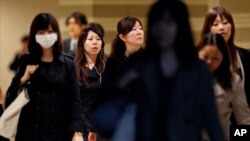Japan's latest census confirmed the hard reality long ago signaled by shuttered shops and abandoned villages across the country: the population is shrinking.
Japan's population stood at 127.1 million last fall, down 0.7 percent from 128.1 million in 2010, according to results of the 2015 census, released Friday. The 947,000 decline in the population in the last five years was the first since the once-every-five-years count started in 1920.
Unable to count on a growing market and labor force to power economic expansion, the government has drawn up urgent measures to counter the falling birth rate.
Prime Minister Shinzo Abe has made preventing a decline below 100 million a top priority. But population experts say it would be virtually impossible to prevent that even if the birth rate rose to Abe's target of 1.8 children per woman from the current birthrate of 1.4.
Without a substantial increase in the birthrate or loosening of staunch Japanese resistance to immigration, the population is forecast to fall to about 108 million by 2050 and to 87 million by 2060.
Tokyo's rush hour trains are just as crowded as ever: Japan's biggest cities have continued to grow as younger workers leave small towns in search of work. The census showed Tokyo's population grew to 13.5 million, up 2.7 percent since the 2010 census.
But a visit to any regional city will find entire blocks of small shops shuttered, the owners usually either retired or deceased. In rural areas, even just outside Tokyo, villages are mostly empty, fields overgrown and bus and train services intermittent thanks to scant demand.
The rate of population growth peaked in 1950 and has fallen continuously since 1975. By 2011 it had hit zero, the census figures show.
Though Japan is leading this demographic shift, the rest of Asia is following. In South Korea, China and elsewhere in Asia, improved life spans and falling birthrates are raising worries over how to provide for the rapidly expanding ranks of seniors with shrinking labor forces.
A World Bank report issued late last year forecast that health and pension spending will rise sharply at a time when elders can count on less support from their families.
“The rapid pace and sheer scale of aging in East Asia raises policy challenges, economic and fiscal pressures and social risks,” the report said.
It recommended that governments facilitate more participation in the labor force by women and seniors, provide better childcare and elder-care, and revamp their pension and health systems to cope.
For Japan, the demographic crunch is one of the biggest challenges to a postwar economic model based on rising incomes and consumption.
Nearly a third of all Japanese were over 65 years old in 2015. By 2050, almost 40 percent will be older than 65, according to projections by the National Institute of Population and Social Securities Research.
Richard Katz of The Oriental Economist forecasts that by 2045 there will be 13 percent fewer workers per person in Japan. That means each worker would need to produce 13 percent more in terms of economic value to offset the decline and maintain current living standards.
Japan's economy has stagnated for most of the past two decades partly because companies are reluctant to invest in a market they are convinced will continue to shrink.
Abe took office in late 2012 vowing to spur growth through massive stimulus and sweeping reforms to improve Japan's competitiveness. So far few of the reforms have been realized, though corporate profits soared thanks to the resulting weakening in the Japanese yen against other currencies.
Meanwhile, Abe's growth agenda has stalled, as companies have opted to invest their cash piles overseas, in faster growing markets, instead of upgrading factories and raising wages - moves that might stimulate demand inside Japan.







